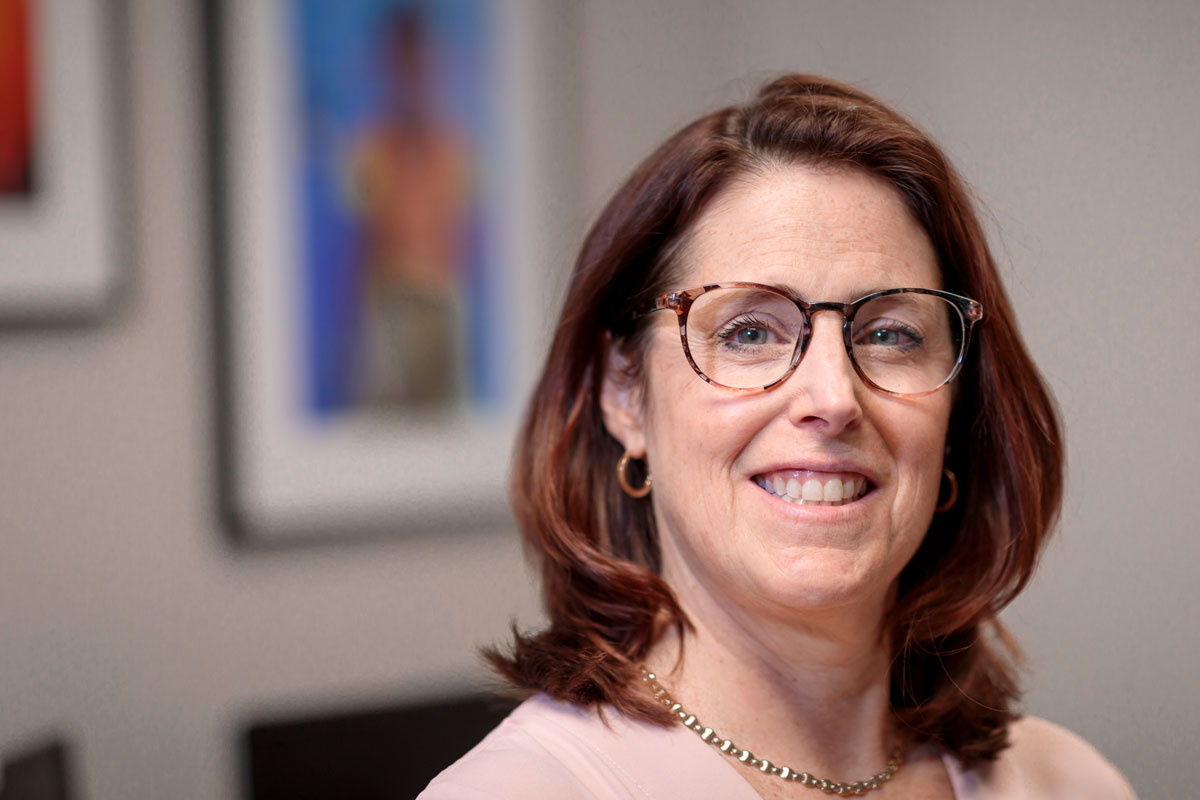Washington People: Tracy Spitznagle
Physical therapist has evolved into an advocate for women who have had difficult births
 Matt Miller
Matt MillerTracy Spitznagle, DPT, shows a model of a pelvis to pregnant patient Kim Hofmann. Spitznagle is a professor of physical therapy and of obstetrics and gynecology.
As a high school student, Tracy Spitznagle knew she wanted to be a physical therapist. However, she had no idea that in becoming one she would influence how women’s health care is delivered, not only in St. Louis, but across the world in Africa.
As a freshman and avid reader at Kirkwood High School in the St. Louis suburbs, she developed an interest in quadriplegia and other disabilities. Then, while working as a lifeguard at a camp for girls with disabilities, she had the opportunity to serve as an attendant for a counselor with quadriplegia. She decided then that she was going to work with people with spinal cord injuries.
Spitznagle — now a professor of physical therapy and of obstetrics and gynecology at Washington University School of Medicine in St. Louis — earned her bachelor’s degree in physical therapy in 1986 at Marquette University in Milwaukee and headed back home to St. Louis to launch her career.
“I had attained my goal, so I thought I was going to treat spinal cord patients for the rest of my life at Jewish Hospital, then the premiere rehabilitation hospital in St. Louis,” she said.
Spitznagle has worked in the health-care system ever since, but there have been a few life-changing twists and turns along the way. She has evolved into an advocate for women with pelvic floor dysfunction, which refers to the inability to control the pelvic-area muscles that control bowel and bladder movements. Her expertise has led her to Africa, where she helps women who have had difficult births.
“Tracy’s passion for women’s health is undying, and her willingness to give of herself to improve the lives of others is remarkable,” said Gammon Earhart, PhD, director of the Program in Physical Therapy at the School of Medicine. “She seeks to make an impact not just today, but in the future through engagement in efforts that will make a sustainable difference at the global level.”
Spitznagle — who earned a master’s degree in health science in 1994 and a doctor in physical therapy (DPT) degree in 2006, both from Washington University — discussed her life and career in physical therapy.
 Matt Miller
Matt MillerHow did you come to specialize in treating women with pelvic floor dysfunction?
I worked as a physical therapist providing in-home care early in my career. This was one of the most challenging and fulfilling types of physical therapy I’ve ever done. It allowed me to be very specific with my care, focusing on the in-home needs of the person. I was able to apply everything that I knew about PT, and then some. The beauty of this type of practice is that I was right there in the reality of the person’s life. Many people are incontinent, and their incontinence can drive them to be homebound. This was a big aha moment for me because, as a physical therapist, I had never been exposed to this before.
At the time, I also was working as a lab assistant for the Program in Physical Therapy. In a faculty meeting one day, I learned that the school was going to hire a urogynecologist and that there was a need for physical therapy support. Dr. Susan Deusinger, then the head of the program, said they were looking for physical therapists to train in pelvic floor dysfunction. I volunteered because I had seen firsthand how incontinence causes functional impairments for people and negatively impacts quality of life.
Were there other volunteers?
At the time, I was the only PT faculty member who was interested in the training. And I’ll always remember Susie (Deusinger) coming to talk to me after I volunteered. She told me that I could opt out, since learning a pelvic muscle exam was not a traditional skill for a PT. But I wasn’t worried. I wanted to learn more about pelvic floor dysfunction to help women who need this type of therapy. I also recognized this would be a niche for my professional growth.
How has the field changed here at the medical school over the years?
We’ve created a systemic change over time within the curricula here at the Program in Physical Therapy. When I went to PT school in the 1980s, we didn’t learn anything about women’s health or the pelvic floor. Now, our students learn about the discipline across the curriculum, starting the first year in anatomy and continuing all the way through to the final semester, when we run a focused study in women’s health. Including me, we now have four specialists in the program, and we have a year-long postdoctoral training program for one student.
Until 2009, there wasn’t a board certification in women’s health like there is in the other PT specialties of neurology, orthopedics, pediatrics and geriatrics. It was exciting for me to be involved in petitioning the American Physical Therapy Association to establish certification. And I was among the first to sit for the board exam in 2009.
How did you begin treating women in Africa?
I used to work in the obstetrics and gynecology clinic at the Center for Outpatient Health. This clinic provided pro-bono care for women who needed pelvic floor physical therapy. One main collaborator in the clinical practice was Dr. Lewis Wall. Lewis approached me in the early fall of 2011 and asked if I had any time that December. He said he’d like me to go to Africa with him, and I told him I’d definitely make time.
Lewis had already been working in Africa with women who suffered from traumatic, prolonged births and consequently developed fistulas. Obstetric fistulas are holes between the vagina and rectum or bladder that can leave women and girls leaking urine and feces. Many of these women are divorced by their husbands, disowned by their families and live desolate lives at the edges of their villages. In developed countries, fistulas hardly exist anymore because women have easy access to medical care. But in underdeveloped areas, they are far more common, and women often need surgery and physical therapy to recover.
For my first trip, I went by myself and observed at the Hamlin Fistula Hospital in Addis Ababa, the capital of Ethiopia, and I’ve been going about twice a year ever since.
How do you help the women you work with in Africa?
A lot of leg weakness develops with arrested birth, which occurs when the baby’s head engages in the pelvis and creates nerve, muscle and vascular damage. The pelvic tissues become necrotic and die, which causes damage to the organs and support tissues. Because of this, women have trouble walking and participating in everyday activities. I have the opportunity to work with women before surgery to build leg strength and improve general mobility so that they can be more functional after the fistula is repaired. After surgery, I work with the women to teach them how to do things like get up out of bed without increasing pressure in the abdomen. And there is a percentage of women who still leak after surgery, so we work on pelvic floor exercises to strengthen the muscles in that area.
After surgery, the goal for PT is to work on any functional deficits that are getting in the way of allowing the women to return to their communities. Commonly, they are engaged in a community re-integration program that provides them with skills so that they can generate an income and have a better future.
Tell us about your research.
I have had the wonderful opportunity to work across several interdisciplinary teams here at Washington University. My research interests have been focused on urinary symptoms and the musculoskeletal aspects of pelvic pain. There’s a lot to learn about the muscular component to pelvic health, and I feel honored to be contributing to science in this area.
What’s the best part of your job?
I’ve been able to create a career that’s allowed me to turn compassion into action.
 Courtesy of T. Spitznagle
Courtesy of T. SpitznagleTell us about your personal life.
I met my husband, Rich Spitznagle, at a football game when we both were 17. He told me he was going to marry me three months in, and I told him he was crazy since we met at the wrong time in our lives. We celebrated 31 years of marriage last June. We have two kids: Kate, 26, and Andrew, 28. Both have grown up to be resilient young adults and are working here in the St. Louis area.
We live just outside of Kirkwood, and we love to paddle board, walk along the Meramec River, cook and travel.







